indicator
Ssireum (Traditional Korean Wrestling) – an ancient sport evolved to the modern era
A traditional Korean combat sport, ssireum has evolved from a survival tactic during ancient times to a form of entertainment enjoyed during festivals and holiday celebrations today.
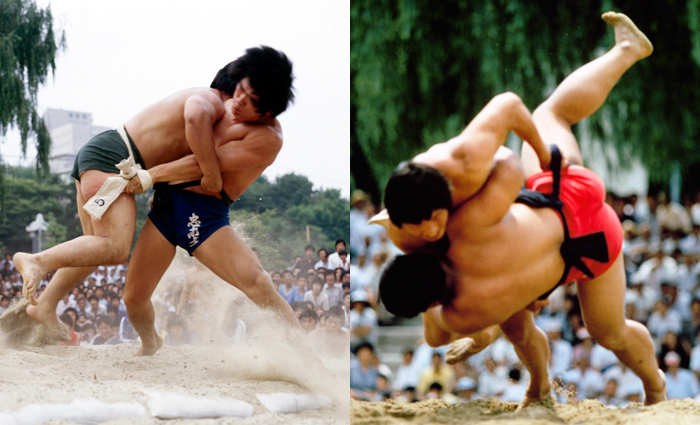
<Ssireum is a traditional Korean combat sport practiced between two competitors, in which one competitor forces the opponent to touch the ground with some part of the body other than the feet.>
Ssireum, a traditional Korean martial art
A traditional Korean sport, ssireum involves using one's entire body in a battle of strength and technique. Two competitors grab one another's belt (called "satba" in Korean) or trouser waist and use a combination of physical strength and strategic technique to be the first to knock the opponent to the ground and be declared the winner. In order to win a ssireum match, physical strength, technique and endurance are required. With the sport's balanced focus on the development of both physical strength and mental fortitude through accurate judgment and patience, ssireum is a highly beneficial sport on many levels. Ssireum is a beloved sport in Korea, and while tournaments are held year-round, they are especially prevalent at holiday celebrations and festivals.
Ssireum, a global sport spanning millennia
Ssireum is believed to have developed naturally in ancient civilization. In primitive societies, people had to fight wild animals and possibly members of other groups for survival. Because only those who could win fights with their bare hands could survive and achieve dominance, prehistoric peoples most likely were forced to quickly learn how to protect themselves without weapons—a skill that developed with the passing of time. Such barehanded fights would have been naturally embraced by primitive religions. Through the generations, religious rituals in which certain gestures resembled fighting poses likely gradually transformed into a form of sport.
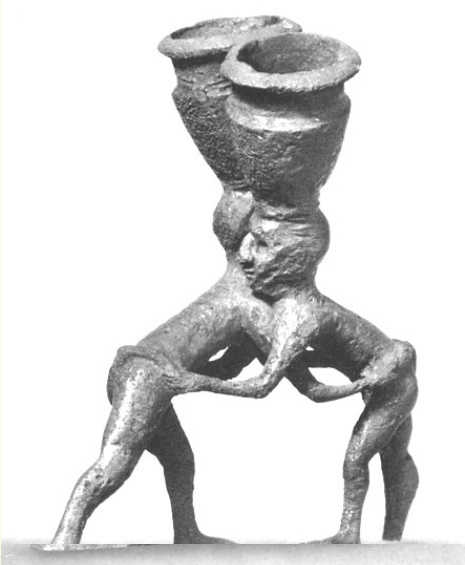
<Wrestling Summerians – circa 2400 BC.>
The evolution of wrestling applies not only to Korea but also to the rest of the world. Although the details of the format vary across cultures, games resembling ssireum exist throughout the world, and every ethnic group and/or nation has its own version of the sport. Like the Dutch bostel, das schwingen of Switzerland, glima of Ireland, koshti of Iran, sambo of Russia, yagli gures (oil wrestling) of Turkey, the Mongol buh, Vietnamese vat co truyen, Japanese sumo, and Chinese shuai jiao, there is a unique traditional form of wrestling similar to ssireum in almost every culture.
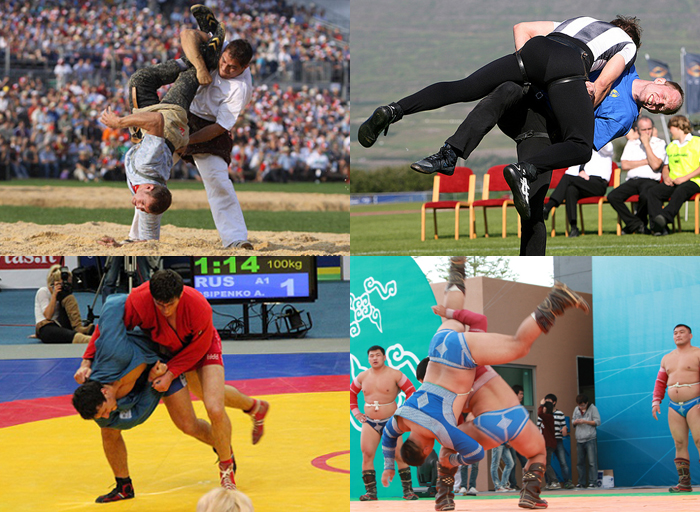
<Wrestling is found in many countries. Clockwise from upper left: das schwingen of Switzerland, glima of Ireland, sambo of Russia, buh of Mongolia.>
As such, although the prototype of ssireum is common to all people and can be traced back to the earliest days of human existence, it is difficult to determine a specific starting point of wrestling by a particular ethnic group or region. According to various relics, wrestling existed as early as 3,000 years before the Common Era. This was the approximate carbon dating of an ancient Babylonian bronze item that was discovered with an engraving of a wrestling scene. An Egyptian wall painting of wrestling is believed to date back to 500 B.C. According to documented evidence, Homer's Iliad, which is considered the oldest epic poem of Greece, contains a story about wrestling. In the Eastern tradition, there is a record from China's Warring States Period that mentions wrestling.
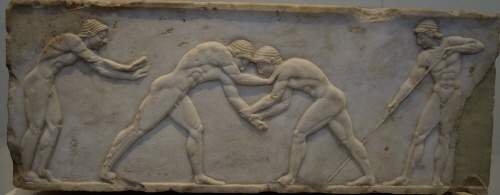
<This flat Greek sculpture shows the origins of wrestling, a sport that is similar to ssireum.>
Ssireum embodies the Korean cultural spirit of festivals and holidays
The earliest records of ssireum in Korea were found on tomb wall paintings of the Goguryeo Kingdom (37 B.C.-668 A.D.). In China, there is a wrestling scene painted onto the wall of a tomb in the Xian District of China's Jilin Province believed to have been built in the late 4th century. The right-side wall of the Anak tomb of Goguryeo features a painting of two strong-looking men engaged in a wrestling match under a large tree with an elderly white-haired man to the right leaning on a cane, supposedly judging the match. The presence of a judge is evidence that ssireum is a sport with rules that must be strictly followed and that such rules already existed in the Goguryeo Kingdom.

<A wall painting that depicts wrestling found in a Goguryeo tomb.>
Tomb 1 of Goguryeo of Jiangzhen, Xian District, Jilin Province in China, which is believed to date back to the mid-5th century, has on its left side a wall painting that depicts wrestling as part of an outdoor merrymaking scene. Onlookers with parasols, horsemen, servants and dogs stand under a large tree. Surrounding them are people engaged in a variety of activities such as acrobatics, wrestling, drumming, playing stringed instruments, and dancing. This painting is evidence that during the Goguryeo Kingdom (37 B.C.-668 A.D.), wrestling was a form of entertainment.
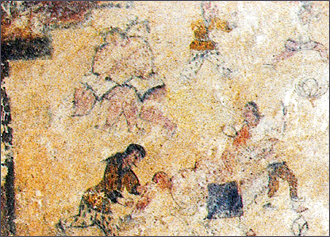
<Goguryeo wall painting that depicts wrestling found in Tomb 1 of Jiangzhen, China.>
In addition to these, there are relatively more recent records of ssireum in historical texts such as the History of Goryeo and the Royal Annals of Joseon. The appearances of various aspects of ssireum in folk and genre paintings also show that the sport was an essential aspect of everyday life for pre-modern Koreans.
Ssireum was a ritualized event in agrarian society. On the fifth day of the fifth month on the lunar calendar (called "dano" in Korean), the village men would gather at a large sand pit or grassy area to show off their strength through ssireum matches. On the full moon of the seventh month a baekjung (literally "among 100") was held, a large ssireum tournament in which strong men from several regions would gather to display their finesse and skill before crowds of hundreds of people. The winner of the baekjung was called a "cheonha jangsa."

<A painting by 18th century Joseon artist Kim Hong-do depicts onlookers watching a wrestling match.>
During the Chuseok holiday in the eighth lunar month, strong men from both the capital city and outlying regions would gather for a national ssireum tournament, each hoping to gain the honor for his hometown of being the tournament winner. To defeat their opponents, participants utilized all the ssireum techniques they knew, including pulling, lifting, pushing, bending at the waist, and tripping.
The winner of this tournament was presented with a bull as a prize. This practice is believed to originate from the fact that most ssireum practitioners in ancient Korea were farmers, and is evidence of the respect people had for the farming profession at that time. The gift of a bull was most likely meant to encourage the winner's farming activities.
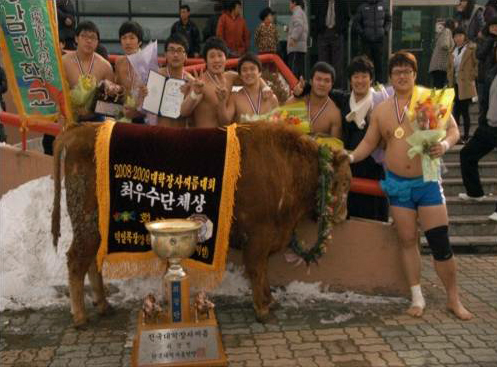
<The tradition of presenting a bull to the winner of a ssireum tournament continues today.>
As such, ssireum was one of the most popular events of any festival or holiday celebration. Unlike most other martial arts, ssireum is special in that it involves direct skin-to-skin contact, befitting the traditional Korean emphasis on a national spirit based on "jeong (mutual affection)". A sport that is simple, exciting, and can be practiced by anyone anywhere, is enjoyable for both participants and spectators. Ssireum is a highly beneficial "social" sport with a long-standing history that continues to be enjoyed and developed today.
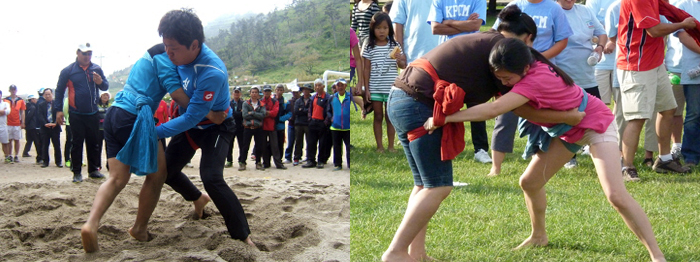
<Ssireum remains a popular activity at large sports gatherings, and is participated in by both sexes and a wide range of age groups.>
* Photos courtesy of Korea Tourism Organization.
